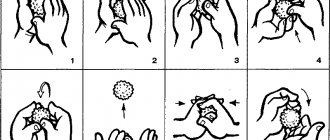To make getting ready to go out quick and painless, it is important not to miss the moment and teach your child to dress himself. Usually, at the age of 2.5-3 years, children’s favorite phrase becomes “I myself.” It is this desire to do everything yourself that can become the basis for the skill of dressing yourself.
It is best to start teaching your child how to dress and undress before he or she enrolls in kindergarten. This way you can make your morning preparations easier, and also simplify the teacher’s work. A child who already has some self-dressing skills feels more confident and comfortable in the garden.
There is no need to rush the child. The skill of dressing independently, like any other skill, is not developed immediately. Support your child's desire for independence, but be prepared to help him if necessary.
Development of independent dressing and undressing skills in preschool children
At 1 year old, a child can take off his socks and hat himself. At 2 years old, children usually know how to take off their panties, tights, pants, and also put on a hat and socks themselves.
At 3 years old, children can most often:
- Put on a hat and socks;
- Take off and put on panties, shorts, pants;
- Wear boots, shoes, sandals with Velcro;
- Take off the jacket;
- Fasten and unfasten the zipper inserted by the elders.
By age 4, a child will learn:
- Wear a jacket, T-shirt;
- Fasten the buttons;
- Undress completely.
Four-year-old children, despite their independence, may still need some help, since their motor skills are not yet well developed. Children of older preschool age are already able to dress without adult supervision.
Rule one. Choosing clothes
Few mothers can resist buying bright, beautiful children's clothes. And not everyone thinks about whether the child will be able to put on these outfits on his own. Meanwhile, kindergarten teachers and parents with experience in “learning to dress” have empirically developed a number of effective rules.
And the first of them concerns the choice of clothing.
- Socks and tights
We all remember cotton tights and socks from our childhood. Yes, it is possible that they stretch quickly, gather in folds at the knees and ankles, fade when washed and quickly tear. But at the same time, they are the most convenient for children’s first independent steps in the process of “learning to dress.” After all, even a very small toddler can put them on without the help of adults.
Tights containing synthetic fibers look attractive longer, fit the leg well, and shed less often. But it’s very difficult for kids to put them on. And if they also have a pattern, then it’s a total disaster. Because on the inside of such tights or socks there are a lot of constriction threads that cling to the fingers, disturb children and make them nervous.
Therefore, at least for the first time, before stable skills are formed, it is better to choose cotton tights and socks. Let's leave beauty for the holidays. And for clothes for every day, comfort is more important.
Leggings (for girls) or sportswear and thermal underwear (for children of any gender) are very good in this sense. Even a very young child can put on and take off such clothing items without any problems.
- Outerwear
The easiest way for children to manage clothes is with large “tractor” zippers. They are easy to fasten, the zippers on these zippers are large, and even clumsy little fingers can handle them. Older preschoolers and younger schoolchildren are quite capable of more complex options for “fasteners”: buttons and buttons.
For cold weather, overalls that form a single unit are very convenient. However, it can be difficult for children to put them on without the help of adults.
A minimum of details that complicate the dressing process is also an indispensable requirement for children's clothing. All sorts of “beauties” will come in handy later, when the child can cope with them without difficulty.
- Mittens and gloves
Of course, it is easier for a child to wear mittens than gloves. But even here difficulties may arise. The inner layer of two-layer knitted mittens has a bad habit of turning out when a child takes them off. Children are often unable to put the inner layer back in place on their own. Tall mittens are a wonderful invention. But if the child puts on the first of them without difficulty, then the second one is not easy to cope with on his own: the one already put on gets in the way. Therefore, you should choose mittens taking into account these and other nuances.
- Shoes
Children under 5–6 years old may find it difficult to cope with zippers on shoes. It is better to opt for models with Velcro or without fasteners at all. Insulated rubber boots or shoes with “boots” made of warm materials (felt, fleece and others) inserted inside are not always convenient for dressing yourself. If these inserts are attached to the shoe, they can pull on the foot and turn out when removed. Children cannot insert them back neatly. The resulting folds rub the legs or interfere with putting on. Approximately the same problems arise with completely removable internal “boots”.
In the photo - Lassie children's clothing
Dressing up is fun!
In order to quickly teach your child to dress and undress on his own, you need to turn this process into an exciting game. As soon as this difficult task becomes interesting for the baby, success will not take long to arrive.
- If the child is very young, he will be interested in taking things out of a box or drawer and then putting them back. Gradually, he will begin to become curious about clothes and want to try them on.
- Children love to play roles. Therefore, role-playing games with dressing up can be an excellent way to teach a child to dress. Buy your child a costume of a doctor, pirate, traffic police inspector or your child’s favorite characters, then he will definitely show interest in dressing up.
- Play games to develop fine motor skills. Make something like a busy board for your child, on which all kinds of fasteners, buttons, Velcro, snaps, and zippers will be placed. This will be a great workout for your baby.
- Add a little fairy tale to your daily routine. Tell your child that you are not just going to go for a walk, but are going on an extraordinary journey, for example, into space. The astronauts are rushing to put on their spacesuits! You can limit the child's time and turn on the timer, but for the time during which the child can actually manage to get dressed. Don't forget to praise your baby and keep him motivated to learn how to dress himself.
- Have a competition. Invite your child to get dressed in a race. At first, lose to your baby so that he feels confident in his abilities. Gradually complicate the rules of the game (for example, clarify that you need to look neat).
When will the baby go
Many parents whose children have not yet taken their first steps are wondering when this will happen. Remember, each child is individual. Some will go earlier, some later. Everything has its time.
So, when a child begins to walk independently (girl, boy), the norm is:
- Nine months to a year is the norm
Usually during this time period the child masters the science of walking. Pay special attention to your child during this time. Some toddlers can stand well on their legs and even move from place to place, but it is not always possible to sit down and rest. Hence the load on the spine. At first, don’t let your baby stand a lot, sit him down to play so that he doesn’t get tired.
- Before nine months
It happens extremely rarely that a baby begins to walk at less than nine months. This should not be a cause for concern for parents. But remember, you never need to push your child. The norm is if he walked on his own and spontaneously.
- Children are early risers
It also happens that a child’s motor activity is very developed from birth. Such babies can start at 7.5 months. According to the doctor, such early activity does not bode well, as the spine experiences a lot of stress. Observation is important; if the child is strong, loves to walk and this does not cause him any discomfort, then there is no reason to worry.
If the baby is already a little over a year old, but he still does not walk and does not strive to do so, parents have cause for concern;
Of course, this may cause concern, but an absolutely healthy child can go later than his peers. Pediatricians set a lower limit of one and a half years. So Dr. Komarovsky strongly recommends not to rush children, not to push them to walk early.
Tips for parents
Start teaching your child to undress and dress himself from an early age. It's no secret that children find it easier to undress than to dress. Already at the age of one year, a child is quite capable of taking off his hat and socks. If something doesn’t work out for your child, don’t rush to come to his aid, let him try to overcome the difficulties himself. You can only direct his actions in the right direction, but do not do for the baby what he can do himself. Also, don't worry if results don't appear right away. Here are some tips to help you teach your child to dress himself.
- Sometimes children are afraid of not being able to cope with too much clothing. Start teaching your child to put on one thing on his own, for example, a hat. Gradually increase the number of things.
- Give your child visual cues. Some kids have a hard time remembering the sequence of putting things on. Draw a poster-cheat sheet or arrange things in the right order in advance. Teach your child to consult the “cheat sheet”.
- Choose your clothes for tomorrow in advance. Let your child participate in choosing clothes for the next day. In the evening, with your help, your child can lay out a set of clothes for tomorrow in the order in which they should be dressed, which will greatly save your time the next morning.
- To prevent your child from confusing where the back of the clothes is and where the front is, try to buy clothes with pockets, pictures on the front, or make conventional marks on the clothes yourself.
- For babies who are just learning to dress themselves, it is better to buy clothes a size larger. In this case, it will be easier for the child to pull on the sleeves and put the head through (this especially applies to turtlenecks).
- Be flexible. Perhaps the baby is naughty or refuses to get dressed because he is simply not in the mood or is sick. If you insist on your own, you may encounter strong resistance. Therefore, in this case, try to come to an agreement with the child. For example, a mother can put on pants, and a child can put on a sweater, etc.
- Buy clothes with your child. The baby will be very willing to wear what he has chosen himself.
Often children refuse to wear this or that item simply because it is uncomfortable. Clothes may not fit the child in size and may be unpleasant to the touch. Therefore, if your child doesn’t like something, try to find out the reason from him.
Why is it necessary to teach your child to dress himself?
The child will always seem small and inept to his parents. In an effort to protect their children from difficulties, parents often complicate their future lives. A child’s lack of such simple self-care skills as getting dressed can lead to negative consequences in the future.
Firstly, by constantly serving a child, we deprive him of the ability to take care of himself without the help of adults.
The result of a lack of self-care skills can be sloppiness and untidiness. The appearance must not only be created, but maintained throughout the day.
Failure to do this will lead to the habit of being unkempt, a lack of control over one’s appearance, and a dependent, sloppy child often becomes the subject of ridicule from peers, which painfully wounds the fragile psyche.
Secondly, since self-service skills relate to labor education, parents ignoring this direction of the child’s development will lead to the formation of a negative attitude towards work and laziness.
Third, dressing is an everyday skill, and its absence may cause parent-child conflict. Daily conflicts spoil a child’s character and create capriciousness, egocentrism, and stubbornness in a child. Unfortunately, these traits will not disappear on their own; they will need to be dealt with using special methods, but it is better to prevent their development in preschool age.
Fourthly, the inability to act independently will require outside intervention. The child gets used to the fact that someone (an adult) must help him manipulate clothes and shoes. The combination of words “should help” indicates the formation of negative personality traits - disrespect for others, a consumerist attitude towards life. Naturally, all these negative manifestations will not arise overnight. But “if you sow a habit, you will reap a character,” our wise ancestors said, and they were certainly right. It is from such little things as the reluctance to dress yourself that a consumer attitude towards those around you begins to form. First, the adult must dress the child, and then his responsibilities in the eyes of the child will expand very quickly.
The ability to dress independently leads to the ability to control one’s appearance, teaches neatness, develops aesthetic taste and respect for work and elders.
conclusions
Teaching a child to dress independently is not an easy task. You should gradually teach your child to be independent from an early age. Give your child tasks he can do. Gradually, the skill of dressing and undressing will improve, and the baby will be able to dress himself. If you encounter resistance and whims, try to find out the reason for the child’s behavior and act according to the circumstances. Turn the process of dressing into an interesting game, praise your child for his success, then you will definitely achieve results!
Why can't children dress themselves?
It must be said right away that only adults are to blame for the fact that children do not know how to dress themselves. True, adults themselves have a number of excuses for this:
- haste: “we cannot afford measured training in dressing skills in the morning, as we are in a hurry”;
- the desire for perfection: many parents believe that they will dress their child faster and better;
- maintaining normal relationships: dressing independently often leads to whims and hysterics, which are easier to prevent altogether than to stop.
Psychologists do not accept such excuses, calling them in one word - laziness.
Parents whose children do not know how to dress, as a rule, do not bother:
- early rises and strict adherence to the regime, so there is a rush in the morning;
- classes with children to teach them how to manipulate buttons, laces, zippers, Velcro, and explain the features of putting on various types of clothing;
- joint activities with the child in caring for clothes.
So, it has become clear who is to blame, now we need to figure out what to do.
What problems may arise and how to solve them
There are some nuances in mastering the skill of walking. These “pitfalls” can slow down the process of their development.
- Physiology. There is no way to get away from this. This is the first and main reason why a child begins to walk later than others. For example, it is more difficult for a large baby to stand on his feet. Than his slimmer peer. If you are faced with this particular problem, then you should monitor your baby’s diet, try to balance it and, of course, seek help from a specialist.
- Genetics. Children usually take a lot genetically from their parents. Remember what time you or the baby’s grandparents went. Perhaps you will find the solution.
- Temperament. All babies are different in character. Some are calm melancholic, others are temperamental sanguine. If the child is very calm, you should try to stir him up a little, come up with entertainment that can arouse interest in physical activity.
- Walkers. The baby loves to walk, but is already used to a walker and does not want to “work independently.” The solution is simple and unique: no walkers, no problems. The baby will try to walk on his own because his assistant has disappeared.
- Fear of falling. The problem described in this paragraph is psychological. The child is just starting to walk. He may fall down several times and develop a fear of falling again. Because of his fear, he does not risk attempting to walk again. You should support your child, he should feel your love and support. Offer him your help, for example, hold his hand. Praise for success. Soon he will begin to feel more confident.
- Individual characteristics. Premature babies are slightly behind in their development compared to their peers. If a child was born a month or two early, you should understand that he will develop according to his biological age. In the beginning, it may be difficult for him to catch up with children born on time, but this is not a reason to worry. Help your baby develop physical skills. As practice shows, premature babies catch up with their peers after a year.
- Illness, stress. If a child’s reluctance to walk is expressed in stress from an illness, you need to give him time and surround him with care. The baby will definitely remember all the skills he learned before the disease. Your love, believe me, works wonders.
If you cannot walk due to illness, only the help of a qualified doctor and his instructions will help.
Myth! Previously, there was an opinion that girls begin to walk earlier than boys. But this is rather a myth. Experts say that everything is individual and does not depend on gender.
Calm, just calm!
The most important thing is to be patient ! As soon as the child gets a taste and feels interest in the process, the matter will drag on. He will not let you near him, wanting to do everything on his own, and he himself will do everything slowly and clumsily.
Follow a few rules:
• start getting dressed 20 minutes before you plan to leave the house;
• prepare clothes for the child and arrange them in the order in which he should wear them;
• do not dress yourself until the child is dressed, so as not to get wet while waiting;
• prepare yourself a book or a 20-minute task that you can postpone at any time;
• buy clothes for your child with a minimum number of simple fasteners.
Help in mastering the skill of walking
It is not easy for your child to learn new things, especially walking. This is a leap for the child, entering a new stage of development. Although there is no need to rush your child to learn a new skill, you will still need something to teach your child to walk correctly.
- Parents need to engage in the physical development of the child and strengthen his health from the cradle with the help of massages, strengthening procedures, gymnastics, etc.
- Make sure your baby has plenty of space. You should not “imprison” your child in a playpen or restrict his movements. This way he will be more likely to want to learn to walk, because a child is interested in exploring everything around him. The main thing is to watch your child.
- Be careful when choosing your first shoes.
In fact, this point is one of the main ones.
How convenient and comfortable it will be for the baby to move depends on the shoes. “Shoes” must have a solid back and an instep support for proper formation of the foot. If your baby walks on his toes, he most likely has a problem with his feet. You need to consult an orthopedist and neurologist. Doctors will prescribe special shoes if necessary and prescribe treatment.
You should also consult a doctor immediately if your child cannot walk independently after one and a half years, without support and your help.
In other cases, don’t lose your head, let your offspring develop harmoniously!











